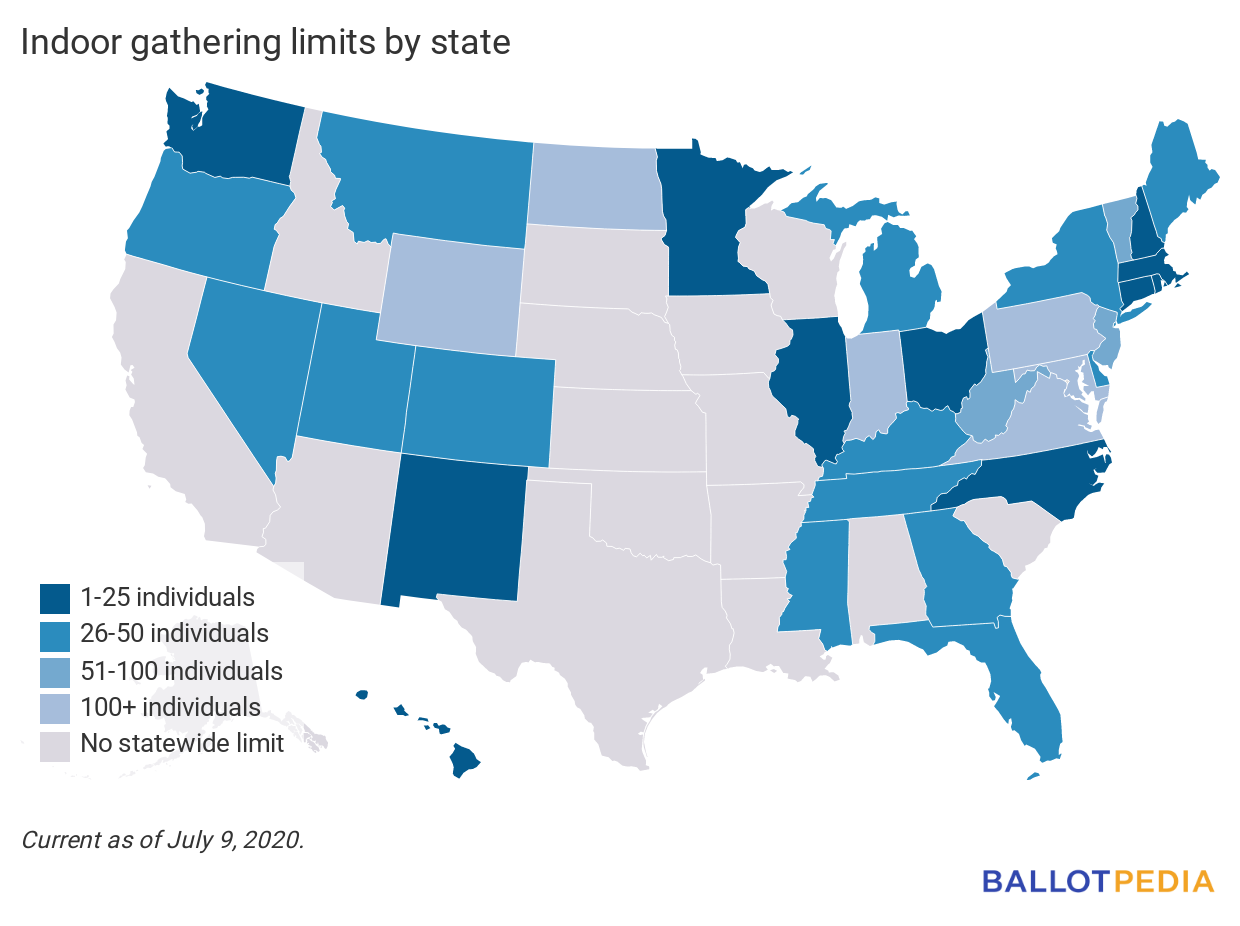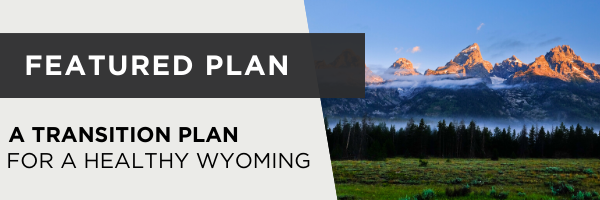Each day, we:
- Track the status of reopening in all 50 states.
- Compare the status of one industry or activity across the country.
- Provide in-depth summaries of the latest reopening plans.
- Give you the latest stories on other reopening plans and ideas.
Want to know what happened yesterday? Click here.
The next two days
What is reopening in the next two days?
July 10
- New York (Democratic trifecta): Gov. Andrew Cuomo announced malls will be able to reopen in Phase IV of the state’s reopening plan starting July 10. Before they reopen, malls will be required to implement ventilation protocols with HVAC systems capable of filtering the coronavirus.
Since our last edition
What is open in each state? For a continually updated article on reopening status in all 50 states, click here. For our last edition, click here.
- Kentucky (divided government): On July 8, Gov. Andy Beshear (D) said he would announce a new series of requirements in response to rising COVID-19 case numbers in Kentucky. Beshear said, “The rising case numbers are cause for concern, so tomorrow we’re going to announce some new requirements that are going to be mandatory. Given what we are seeing across the country with exploding numbers in certain places, my commitment is to make sure that doesn’t happen here, but I can’t do it alone.” Beshear is expected to make the announcement at 4:00 p.m. on July 9. We will have full details in our July 10 issue.
- Maine (Democratic trifecta): On July 8, Gov. Janet Mills (D) issued an executive order establishing expanded enforcement provisions for the state’s existing face-covering requirement. The order mandates that businesses require face coverings in retail stores with more than 50,000 square feet of shopping space, restaurants, outdoor bars and tasting rooms, and lodging establishments. The order applies to businesses in the counties of Hancock, Waldo, Knox, Lincoln, Sagadahoc, Cumberland, and York, and in the cities of Bangor, Brewer, Lewiston, Auburn, and Augusta. The requirement can be enforced by any governmental agency or official “that regulates licenses, permits, or otherwise authorizes the operation or occupancy of eating establishments, bars or tasting rooms, lodging operations and accommodations, businesses, buildings, parks and campgrounds.”
- Ohio (Republican trifecta): Gov. Mike DeWine (R) announced the release of minimum guidelines for colleges and universities reopening in the fall.
- North Carolina (divided government): Gov. Roy Cooper (D) said on July 9 that he would announce new details on the state’s reopening plan next week. North Carolina is in Phase 2 of reopening. Cooper also said he would make an announcement about reopening schools in the fall.
- Texas (Republican trifecta): On July 9, Gov. Greg Abbott (R) issued a proclamation suspending elective surgeries in hospitals in 11 of the state’s trauma service areas. Texas is divided into 22 trauma service areas. The proclamation was aimed at expanding hospital capacity to deal with a surge in coronavirus cases.
- Utah (Republican trifecta): On July 9, Gov. Gary Herbert (R) announced that when K-12 schools reopen, all students, faculty, staff, and visitors will be required to wear masks in buildings and on buses.
- Wisconsin (divided government): Gov. Tony Evers (D) issued an order requiring state employees to wear masks at all times in state buildings beginning on July 13. State buildings will also be closed to the public indefinitely.
Update on stay-at-home orders
Forty-three states issued orders directing residents to stay home except for essential activities and the closure or curtailment of businesses each state deemed nonessential. Seven states did not.
As of July 9, stay-at-home orders have ended in 41 states. Nineteen of those states have Republican governors and 22 have Democratic governors (including Wisconsin, where the state supreme court invalidated the stay-at-home order).
California and New Mexico, both of which have a Democratic governor, are the only remaining states with an active stay-at-home order.
Tracking industries: Indoor gathering size limits
All 50 states are reopening in some way. Here, we give the status of one industry or activity across the states. Today’s question: what is the indoor gathering size limit in each state?
We last looked at indoor gathering size limits in the June 4th edition of the newsletter.
- Sixteen states have no statewide indoor gathering size limit. Twelve of those states have Republican governors and four have Democratic governors.
- On June 4, ten states had no limit.
- Eleven states have a limit between 1 and 25. Eight of those states have Democratic governors and three of those states have Republican governors.
- On June 4, 28 states had a limit between 1 and 25.
- Fourteen states have a limit between 26 and 50. Nine of those states have Democratic governors and five of those states have Republican governors.
- On June 4, nine states had a limit between 26 and 50.
- Three states have a limit between 51 and 100. Two of those states have Republican governors and the other state has a Democratic governor.
- On June 4, one state had a limit between 51 and 100.
- Six states have limits greater than 100. Four of those states have Republican governors and two of those states have Democratic governors.
- On June 4, two states had limits greater than 100.

|

This is an in-depth summary of one of the latest reopening plans. Is there a plan you’d like us to feature? Reply to this email and let us know. Click a state below to read a previous Featured Plan.
On April 23, Gov. Mark Gordon announced the state could start reopening by April 30 and released A Transition Plan for a Healthy Wyoming. In a press release, Gordon said, “Our transition must be health data-driven, not date-driven. If the people of Wyoming continue to do the right thing and we see the improvements we need to see, we will continue our transition.”
The transition plan described general parameters for reopening: “The transition will be gradual and phased. In the weeks and months ahead, Wyoming residents should know there may be future actions, orders and recommendations put into place to continue to protect lives.” The plan also said the state might reopen along regional or local lines, depending on health data.
Unlike many other states, Wyoming’s plan did not include a comprehensive list of planned phases.
According to the document, the state’s reopening decisions are based on the following metrics:
- Number of new cases over time
- Number of cases attributed to community spread over time
- Positivity rate
- Number of COVID-19 hospital admissions
- Stability of hospital bed availability
- Stability of ICU bed availability
Context
- Wyoming did not issue a statewide stay-at-home order. Gordon issued an order closing what the state classified as non-essential businesses on March 20.
- As of July 8, there had been 1,404 confirmed positive cases of COVID-19 in Wyoming and 21 confirmed deaths. A total of 38,577 residents had been tested, amounting to a positive test rate of 3.6 percent. As of July 2019, Wyoming’s estimated population was 578,759. Per 100,000 residents, there have been 242.6 confirmed positives, 3.6 confirmed deaths, and 6,665.5 total tests.
- Wyoming is a Republican trifecta, with a Republican governor and Republican majorities in both chambers of the state legislature.
Plan details
Wyoming’s transition plan did not contain guidance or requirements for businesses or individuals. Below is a timeline of executive orders issued by the governor and other state officials, starting with the March 20 business closure.
March 20
Gordon ordered the following businesses and services to close:
- Schools (K-12 and colleges)
- Theaters
- Dine-in services at restaurants and bars
- Employee cafeterias
- Nightclubs
- Gyms
- Museums
March 21
State health officer Dr. Alexia Harrist issued a supplemental order for individuals prohibiting gatherings of over 10 people.
May 1
Gordon authorized the following businesses and services to reopen:
- Gyms
- Personal care services (including barbershops and salons)
May 13
State health officer Dr. Alexia Harrist issued a supplemental order for individuals raising the gathering limit to 25 people.
May 15
Gordon authorized the following businesses and services to reopen:
- Gyms (classes up to 20 people)
- Indoor and outdoor dining service at bars and restaurants
- Movie theaters and performance venues
- Nightclubs
- Childcare centers
May 27
Gordon raised limits for outdoor gathering to 250 people.
June 10
Gordon authorized the following businesses and services to reopen:
- Schools (K-12 and colleges)
June 15
Gordon raised limits for indoor gatherings to 250 people with social distancing or 50 people when social distancing is not possible.
June 17
The state updated guidance to allow for outdoor visitation at long term care facilities.
Additional activity
In this section, we feature examples of activities by other federal, state, and local governments and influencers relevant to recovering from the pandemic.
- Houston Mayor Sylvester Turner announced the cancellation of the state convention of the Republican Party of Texas. The convention had been scheduled for July 16 through July 18 at the George R. Brown Convention Center. Turner cited the COVID-19 epidemic in Houston as the reason for the cancellation. State Republicans criticized the move, saying they intended to pursue legal action against the city.
- Maryland Governor Larry Hogan (R) ordered the state board of elections to automatically send all qualified voters absentee/mail-in ballot request forms for the Nov. 3 general election. Hogan also ordered that all early voting centers and all Election Day polling locations be open on Nov. 3 for voters who choose to cast their ballots in person.
- On July 7, Michigan, California, the District of Columbia, Maine, New Mexico, and Wisconsin sued U.S. Secretary of Education Betsy DeVos in the U.S. District Court for the Northern District of California, alleging the U.S. Department of Education has unlawfully and erroneously interpreted the Coronavirus Aid, Relief, and Economic Security Act (CARES Act). Plaintiffs claim the CARES Act “directs states to distribute CARES Act funds to local educational agencies” in proportion to “the number of children who are economically disadvantaged,” in accordance with Title I of the Elementary and Secondary Education Act of 1965 (ESEA). The plaintiffs say, counter to congressional intent, the Department’s allocation of the $30.75 billion earmarked for schools has been based on the total number of all students—public and private—regardless of economic disadvantage. Plaintiffs say this “deprives low-income and at-risk students, their teachers, and the public schools that serve them of critical resources to meet students’ educational and social-emotional needs during and after pandemic-related school closures.”
- Disneyland began its first phase of reopening on July 9, opening its Downtown Disney shopping and dining district. California Gov. Gavin Newsom (D) has issued orders affecting Orange County that restricts restaurants to outside service only.
|



